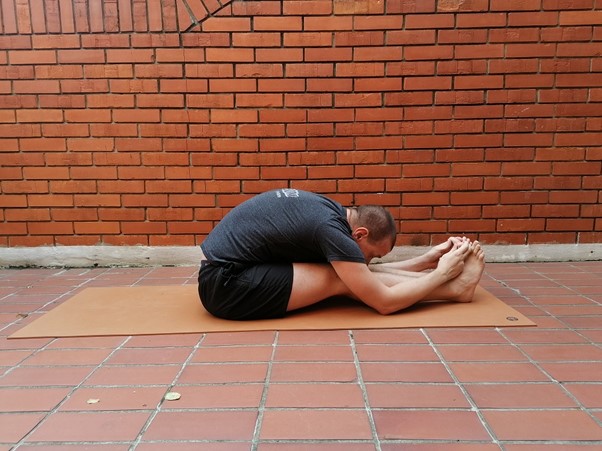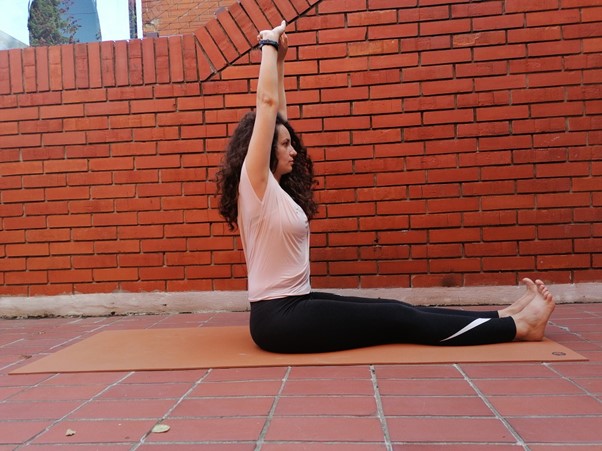The Seated Forward Bend Pose or Paschimottanasana is an excellent asana for stretching the back side of your entire body. It can help ease tension and anxiety and quiet the mind. Additionally stimulating the stomach organs, this yoga position promotes digestion.
This informative piece follows this asana’s fundamentals and covers the benefits and contradictions in-depth. By the end of this article, you’ll know everything you need about the seated forward bend pose!
What Is Paschimottanasana (Seated Forward Bend Pose)?
Paschimottanasana is a seated forward bend pose that lightly stretches the hamstrings, back, and shoulders while lengthening the spine. The word “Paschim” in Sanskrit means west or posterior, “uttana” means intense stretch, and “asana” means pose or posture. So, the direct translation of this asana is “intense stretch of the posterior.” It is usually recommended as a warm-up pose in a yoga routine.
The asana is quite popular and has a bunch of names. You might know it by its alternative names, such as Intense Back Stretch Pose, Entire Back Stretch Pose, and West Stretch Pose. Some might think it sounds intimidating, but this is considered a beginner-level yoga pose. Don’t fret! You can ease into this asana with the correct technique and regular practice. Let’s move ahead to see how you can do this pose and what benefits it has in store for you.

Paschimottanasana
How To Perform the Paschimottanasana
In this segment, we’ll see the step-by-step instructions for performing Paschimottanasana:
- Begin by sitting on the yoga mat with your legs stretched out in front of you. Keep your spine erect and place your hands on your respective knees.
- Take a deep breath, raise your arms, exhale, and lean forward from the hips while maintaining a straight spine.
- Hold your big toes with your respective hands and try to touch your forehead to your knees. Remember to exhale as you bend forward.
- Stay in this position for a few deep breaths, and return to the starting position by inhaling and raising your torso.
What Are the Significant Benefits You Derive from This Asana?
Paschimottanasana is a brilliant yoga practice and has a ton of benefits, including:
Stretching and Lengthening the Spine
When you bend forward in this pose, your back muscles get a good stretch, which helps improve your posture. Practice this asana to give your spine a good stretch.
Stimulating the Abdominal Organs
Paschimottanasana also helps in massaging and stimulating the abdominal organs, such as the liver, kidneys, and pancreas. This aids in better digestion and prevents constipation.
Targets and Works on Belly Fat
Performing this asana regularly can help you eliminate that stubborn belly fat. When you fold forward, your abdominal muscles contract, which helps tone them and burns belly fat.
Soothes Stress and Anxiety
Incorporating this asana into your routine effectively relieves stress and anxiety. It calms the nerves, helps you feel more relaxed, and can assist in mild depression. The body stretch in this pose also helps release muscle tension.
Improves Blood Circulation
Paschimottanasana aids in improving blood circulation, especially in the brain. When you bend forward, the blood flow to the brain increases, which helps improve concentration and memory power.
Aids in Correcting Poor Posture
A bad posture can significantly affect your personality and overall body health. Regular Paschimottanasana practice will help you correct your posture and relieve back pain if you struggle with a hunched back or rounded shoulders.
Relieves Back Pain
This asana can help relieve the discomfort experienced by people with mild back pain. The stretch in the back muscles helps ease the tension and pain. If you practice it regularly, you can say goodbye to back pain for good!
A Good Setup for Meditation
When you sit in this asana with a straight spine and relaxed muscles, it provides the perfect setup for meditation. The asana quiets the mind and relaxes the body, which helps you focus better on your meditation.
Eases Menstrual Discomfort
It is a noteworthy aid for women who experience pain and discomfort during their menstrual cycle. The stretch in the abdominal muscles helps reduce cramps and pain.
Provides Better Sleep
Paschimottanasana is an excellent way to get better sleep. It relaxes the senses and body and calms your nervous system, inducing better sleep. If you have trouble sleeping, this asana can be of great help.
Contradictions of This Asana
From the long list of benefits discussed, we can see that the Paschimottanasana is a very beneficial asana, but there are a few contradictions. These are:
- People with high blood pressure or heart problems should not do this asana as it can increase the heart rate.
- If you have a neck injury, this asana should done very carefully.
- Women who are menstruating should do this pose with a pillow under their belly and also should not stretch all the way.
- For pregnant women, this asana should be avoided as it can put pressure on the uterus.
- Also, people having back pain should practice this pose under the guidance of a proficient professional.
- If you have back disc-related issues like Sciatica, you should not go all the way to the toes but just halfway and hold for a few seconds before returning to the original position.
Lastly, we’ll leave some tips on how to make the most out of your Paschimottanasana experience.
Beginner’s Tips
While performing this asana, remember the following tips:
- Keep your spine erect, and do not round your back.
- Do not strain your neck; just let it relax.
- Keep your breath steady and smooth while performing this asana.
- Do not force your body into the position.
- Position your hands on your shins if you cannot hold your toes.
- Be careful not to overdo this asana.
If you follow these tips, you will be able to do the asana without any difficulty, and you’ll be able to reap the full benefit of the yoga pose.
Conclusion
We hope this article helped you understand the benefits of Paschimottanasana and how to do it. Keep in mind to gradually raise the intensity after a modest start. Remember the contradictions and tips we shared with you, and make the most of your yoga experience. Have an enjoyable practice!








